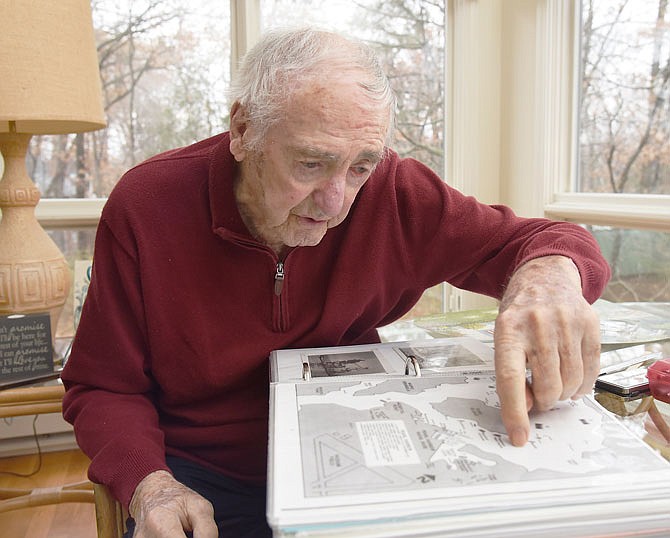At age 97, Bill McAnany has a photographic memory.
The retired businessman and Navy veteran graduated high school and served in the service a lifetime ago. But he can still rattle off fine details from his youngest days in the 1920s, 1930s and 1940s.
On Dec. 7, 1941, while working as an X-ray technician in the Navy Hospital Corps., images were burned into McAnany's mind that he will never forget.
"The water was nothing but flames," he said of his experience surviving the surprise Japanese attack on the U.S. Naval base in Pearl Harbor, Hawaii. "We go over to the mess hall and we do what we can cleaning guys up. Mostly, it was grease all over the place."
Members of the Greatest Generation are dying. Of the 16 million Americans who served in World War II, only 496,777 were alive Sept. 30, according to the National World War II Museum.
McAnany knows this better than anyone. His sister recently died at almost age 100.
While he's still here, McAnany wants to spread a message of hope for younger generations and let them know his experience on that sea of fire taught him to treasure every second of life.
A St. Louis native, McAnany ended up at Pearl Harbor on that fateful day after he entered the Naval Hospital Corps in 1938. In October 1941, at age 20, he was transferred to Pearl Harbor where he served as one of four X-ray technicians on the U.S.S. Solace, a 400-bed hospital ship.
During his earliest days, McAnany explored bars and beaches frequented by other Naval folk, but did not have a chance to explore Hawaii until Dec. 7.
Four friends met McAnany at 7 a.m., 48 minutes before the attack began. The group took a cab ride to the Nuuanu Pali Lookout, a mountaintop vista near Honolulu on the island of Oahu.
In the valley below them to their right was Naval Air Station Kaneohe Bay.
The air station took a heavy hit during the attack. Of 33 Catalina Flying Boats stationed at the air station, 27 were destroyed on the ground, according to state of Hawaii historic archives.
While looking in the direction of the Kaneohe Bay Air Station, McAnany and his friends saw the beginning of the attack.
"It's not even 8 'o clock yet, and we see anti-aircraft bursts going up in the sky," he said.
Something felt wrong.
McAnany knew the sight was strange for a Sunday morning, but he did not realize he was witnessing the beginning of one of the most fateful days in American history.
"Corpsmen are not battle people," McAnany said. "We are non-combatants. These guys, they're practicing over there. They're shooting at drones," he said of what he thought he saw.
The reality of what they witnessed hit them within seconds when airplanes careened into the sea. The friends were not in uniform, but were approached by a man in a car who wondered if they were servicemen. The man told them Japanese forces attacked Pearl Harbor, and all servicemen stationed at Pearl Harbor had orders to return to their ships.
At 8:54 a.m., the second wave of 35 fighters, 78 dive bombers and 54 high-altitude bombers hit the base. By this point, all five men put their white uniforms on and boarded a small motor launch vessel as they tried to get back to the Solace.
During the attack, the Solace was stationed about 150 yards from the U.S.S. Arizona, a battleship which was sunk by armor-piercing shells dropped by Japanese torpedo bombers.
Men were blown off their ships during the attack, McAnany said. The water was full of oil and the oil was on fire, he described. As they made their way through the inferno, the group loaded up a boat full of men to take to an infirmary on Ford Island, which was at the center of the attack.
Some men had their skin burned off. Countless others had horrific injuries.
"We were right out in the middle of that (stuff)," McAnany said. "You were seeing things you never saw in movies."
All five men survived the attack on Pearl Harbor. The other four men are dead now, but only one died during World War II, McAnany said.
The men stayed in a hangar that night and Monday and then returned to the Solace that Tuesday.
McAnany's experience treating battlefield wounds aboard the Solace made a lasting impression on him.
"They were struggling to stay alive," he said slowly of the patients he treated aboard the Solace.
During World War II, McAnany served aboard the Solace near the Battle of Guadalcanal. On another hospital ship, the U.S.S. Samaritan, he treated troops from the battles of Guam, Saipan, Iwo Jima and Okinawa.
He was stationed in Tokyo Bay when the Japanese surrendered to Allied forces on the U.S.S. Missouri on Sept. 2, 1945, but he did not witness the event. He also served a year in the Korean War.
To this day, McAnany keeps a scrapbook with memories and photos from his naval days. One small picture of an X-ray shows a bullet lodged near the heart of a patient he treated.
When he speaks to young people about his experience serving in World War II, he always tells them to value life. With tensions rising in politics and the civility in the country fraying, McAnany said he hopes all people will learn to appreciate each other more and to ignore trivial differences.
"We don't know how great life is," he said. "Don't throw your life away because it is a great thing, and you only go around once."

